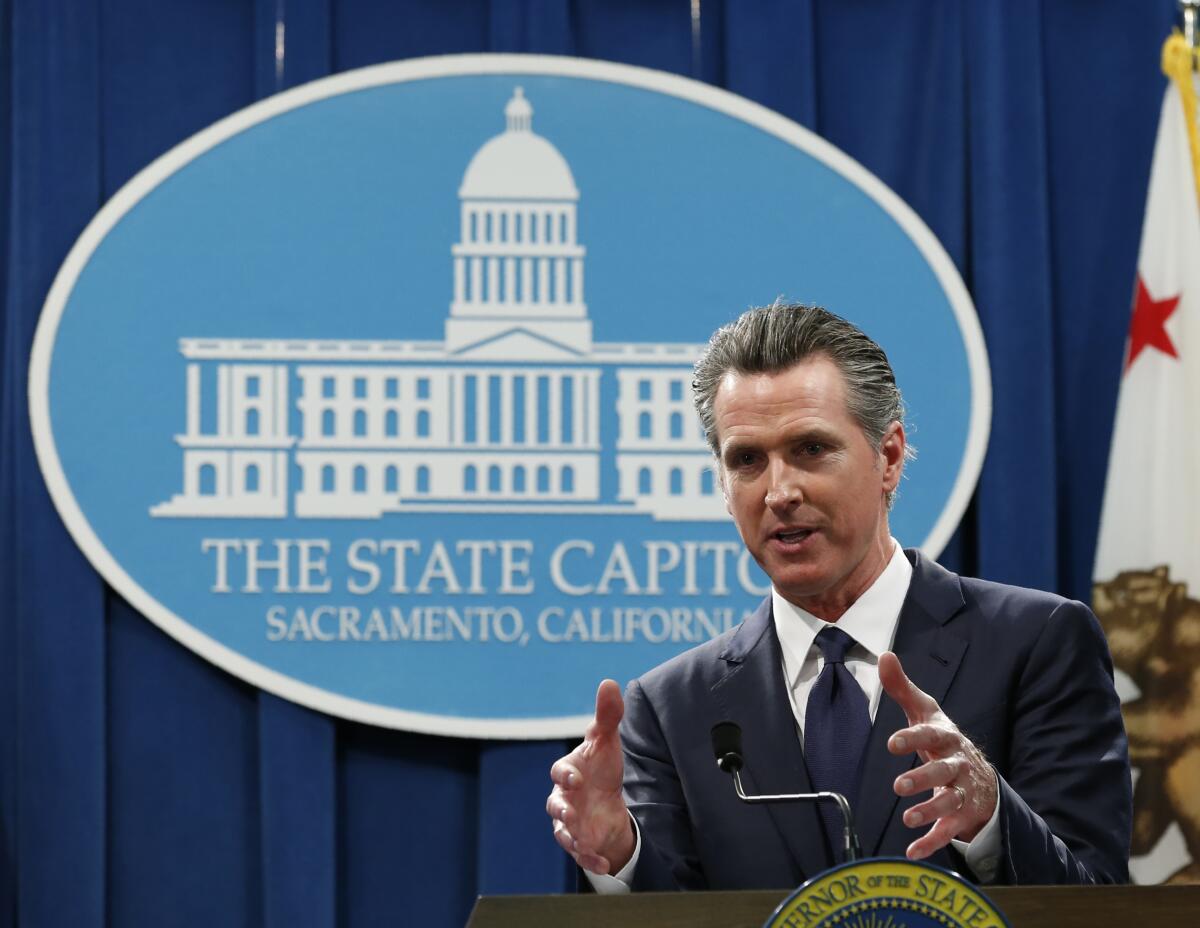Column: Newsom has had lots of luck as governor. He’ll need it for his long list of priorities

- Share via
SACRAMENTO — Each governor is unique. Gov. Gavin Newsom certainly is different.
Jerry Brown was a narrowly focused political pragmatist after evolving from an ambitious young rebel rock star.
Arnold Schwarzenegger was a restless entertainer.
Gray Davis was risk-averse.
Pete Wilson was a scrapper.
George Deukmejian was a rock that could move.
Ronald Reagan: a true believer.
Pat Brown: builder.
Newsom? He’s the lucky one. That’s his most significant trait so far.
He’s lucky because the state treasury keeps overflowing with tax revenue. There’s ample money to spend freely and still save. Unlike his predecessors — particularly Jerry Brown and Schwarzenegger — Newsom hasn’t had had to whack popular state programs to balance the books, angering allies.
Newsom’s also lucky because both legislative houses are controlled by supermajorities of fellow Democrats. They don’t need Republicans for anything.
And since citizens 10 years ago lowered the legislative vote requirement for passing a budget from two-thirds to a simple majority, getting a state spending plan approved is easy. Summerlong budget deadlocks that tarnished the images of all Sacramento politicians are an ugly history.
Newsom is lucky because he has no significant political rivals. Republicans are too weak. Democrats don’t dare. He isn’t pressured politically — except perhaps to begin positioning himself for a presidential run in four or eight years. The governor says he’s not interested. They all say that at this stage.
The telegenic 52-year-old is starting to show faint streaks of gray in his coiffured hair that could turn into a pleasant presidential look when the time comes.
But for the moment, the governor’s focus must be on the mundane matter of state budgeting.
Newsom conducted a remarkable briefing for reporters on his proposed $222.2-billion state budget Friday. He stood at a lectern for nearly 100 minutes delivering a nonstop, uninterrupted monologue on details of his spending plan, covering a wide range of subjects and spewing out reams of numbers.
Then for the next 70 minutes he addressed every question any reporter had, although some queries weren’t actually answered.
The second-year governor was impressive in his knowledge of specifics and seemed to revel in delving into the wonky weeds.
“Two hours and 51 minutes. YEA!,” Senate Majority Leader Bob Hertzberg of Van Nuys declared in a written statement. “For us policy wonks, this is as good as it gets.”
Yes, such gubernatorial enthusiasm for the nuts and bolts of governing and his willingness to publicly share his views are admirable.
That said, Newsom must be the most long-winded governor in California history and unquestionably in the modern era. You’d think a 100-minute monologue could be condensed into a more listener-friendly, effective, message-driven summary lasting a half-hour tops.
It was reminiscent of Newsom’s time as San Francisco mayor in 2008. Rather than delivering a customary State of the City speech, he placed a 7½-hour eye-glazer on his YouTube channel. It bombed.
Newsom began his marathon monologue Friday by warning it was going to be long, explaining: “I want you to know what my priorities are. I want you to know what matters to me.”
But, as chronicled by Times reporters Taryn Luna and Phil Willon, “no topic was too big, no detail too small: tampon taxes, a looming economic downturn, billion-dollar pension liabilities and the food on school lunch trays.”
Besides lucky, Newsom is broadly focused — which can mean unfocused.
When there is a long list of priorities, nothing is a real priority.
Newsom spent 40 minutes talking solely about education, including preschools and child care, as if he were running for state superintendent of public instruction. He was passionate, particularly about special education, noting that as a child he battled dyslexia.
“It’s a miracle I’m here,” he said.
Newsom suggested spending $84 billion of the $153-billion general fund on K-12 schools and community colleges. (Previous Times stories have spelled out precisely what Newsom proposed for education and other state programs.)
Discussing education for 40 minutes would suggest it’s a major Newsom priority. But it was not included among the “three top priorities” for 2020 — “homelessness, healthcare affordability and wildfires” — announced by a senior gubernatorial advisor before the budget rollout.
The healthcare and homelessness priorities include two innovative ideas that offer great promise if Newsom can develop them as he envisions.
One is the governor’s proposal for California to become the first state to sell its own brand of generic prescription drugs. The goal is for the state to negotiate volume deals and provide discount prices for consumers, thereby reducing drug price gouging.
But Newsom didn’t provide details about which drugs he has in mind. He said the state is negotiating but wouldn’t say with whom.
On homelessness, Newsom wants to use the Medi-Cal program — California’s version of federal Medicaid healthcare for the poor — to help house and treat mentally ill people living on the street. That makes much sense and should have been done years ago.
“We believe there’s a tremendous [funding] capacity in the system today that isn’t being utilized,” the governor said.
But that would require federal approval because major Medi-Cal funding comes from Washington. And it doesn’t help that the Newsom and Trump administrations are constantly at each other’s throats.
“If we could move away from these tweets to responsible policy making,” the governor said, not finishing the sentence.
Newsom is hoping for the ultimate luck: a change of presidents in November.
More to Read
Sign up for Essential California
The most important California stories and recommendations in your inbox every morning.
You may occasionally receive promotional content from the Los Angeles Times.











